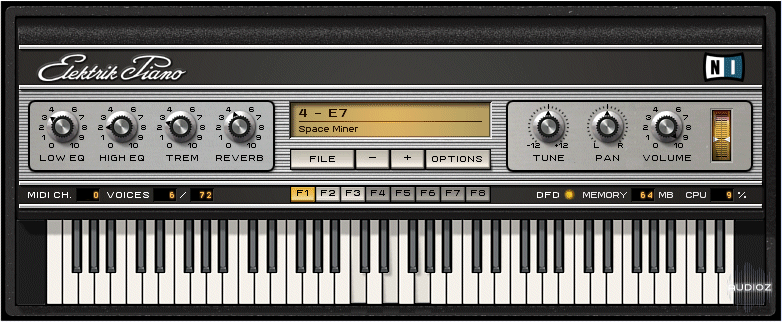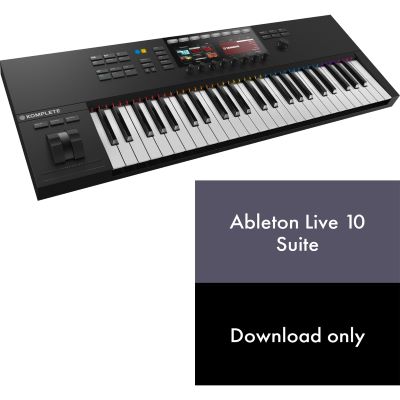Native Instruments Elektrik Piano Download Full
All of Elektrik Piano's samples can also be loaded into Kontakt for further tweaking. NI's Direct From Disk streaming function is also supported to take the strain. New Engine: ELEKTRIK PIANO 1.5 has a brand new engine under the hood. Based on the super-powerful KONTAKT 2 - Native Instruments' award winning sampler engine, ELEKTRIK PIANO 1.5 now features greater stability, much faster loading times, host automation capacity, an improved voice allocation algorithm, thoroughly reworked 'authentic' patches, and numerous other small improvements from version 1.
Thomas @ Ni wrote: Elektrik Piano: Same as with Akoustik Piano, please use the free Kontakt Player. The sounds of Elektrik Piano are also now part of the Kontakt 4 factory library, so they continue to be available within Komplete. Akoustik Piano: The sounds of this instrument can and should be used with the free Kontakt Player, which is a much better platform regarding its sample engine and compatibility. The four individual piano models will also be re-issued as Kontakt-Powered instruments for download in the near future.

For years it was instantly associated with smooth late-'70s productions, and now the sound of the electric piano is enjoying a comeback. But just how good is Native Instruments' sample-based virtual version? Hands up anyone who hasn't heard of Native Instruments. When it comes to virtual instruments, NI produce some of the best around; some of them have yet to be beaten in my opinion, including such gems as Battery, Kontakt, and B4. Elektrik Piano is a virtual rendition of four legendary 'old faithful' electro-mechanical keyboards, namely the Fender Rhodes MkI, the Fender Rhodes MkII, the Hohner Clavinet E7 and the Wurlitzer A200 — a revered set of instruments by anyone's standards. Elektrik Piano is available for Mac and PC. The Mac version supports VST, Audio Units, RTAS, Core Audio and Core MIDI, and requires a minimum specification of Mac OS 10.2.6 and a G4 867MHz processor.
The PC version supports VST, RTAS, DXi, ASIO and Direct Sound, and needs a minimum spec of Windows XP and a Pentium 3 or Athlon 800MHz processor. 2GB of hard drive space and a minimum 512MB of RAM is required on both platforms.
For the purpose of this review, I primarily ran the instrument as a VST plug-in under Cubase on my 2.4MHz Athlon-based PC with 1GB of RAM and can report that it worked flawlessly. Elektrik Piano uses a sample-based audio engine with individual samples taken for every semitone across the keyboard at various velocity levels. Separate samples have also been taken of the release phase of each instrument for added authenticity.
Usefully, the sample material can be loaded straight into NI's Kontakt sample player, which affords possibilities for some serious mangling should the mood strike you. I found the Clavinet samples to be particularly good in this respect, being chunky and full of body, unlike many of the synth emulations we're more often exposed to. I really like the look of this plug-in. I might wish it was slightly bigger on my 1024 x 768 resolution screen, but everything from the faux- Fender logo to the shading around the silver knobs gets brownie points from me. Over to the right of the panel are the tuning, pan and volume controls, with attendant VU metering.
Likewise, targets that have been updated only appear with their most up to date entry information. Like OFAC’s other list-related publications, Sanctions List Search does not contain historical information. Futazh nachalo filjma obratnij otschet cherno belij. OFAC’s Sanctions List Search is updated frequently and always contains the latest versions of OFAC’s sanctions lists. For example, does it show names that have been removed from one of OFAC’s sanctions lists? Names that have been removed from OFAC’s Specially Designated Nationals or Consolidated Lists are not included in Sanctions List Search.

Tuning is available over a ±12 semitone range, while holding the Shift key allows for fine adjustment in cents (hundredths of a semitone). Use of the Shift key to reduce the range of knob movement works across all of Elektrik Piano 's controls. NI have designated each of the four sampled keyboards an Instrument and each of the processed variants of the Instruments are named Presets. Each Preset comes with a flavour of effects or EQ treatments built in.
The centre of the display shows the current Instrument and active Preset. You can choose a Preset by navigating through the 'File' button, or by using the plus or minus buttons to step through them in series. The F1-F8 buttons can each be loaded with a Preset for fast access and these are recalled by clicking the button, using the computer keyboard's F1-F8 keys, or by using a MIDI program change from 1 to 8.
Helpfully, the assignment of the Function buttons (and, indeed, the position of the control knobs) can be saved in a Performance file. Over to the left of the panel are four controls that change assignment depending on the currently selected Preset. They variously become depth, speed, amount and frequency controls for the various reverb, chorus, phaser, panner and equalisers assigned to each Preset. The knobs can be accessed over MIDI by use of controller numbers 20-23, which is helpful for automation or live use. It would be nice to be able to change the MIDI controller number assignments, perhaps to map phaser depth to a mod wheel, or overdrive amount to a breath controller, for example, but NI have gone for a simple approach here.